Hermann Park
Hermann Park is a 445-acre (180-hectare) urban park in Houston, Texas, situated at the southern end of the Museum District. The park is located immediately north of the Texas Medical Center and Brays Bayou, east of Rice University, and slightly west of the Third Ward. Hermann Park is home to numerous cultural institutions including the Houston Zoo, Miller Outdoor Theatre, the Houston Museum of Natural Science, and the Hermann Park Golf Course, which became one of the first desegregated public golf courses in the United States in 1954. The park also features the Mary Gibbs and Jesse H. Jones Reflection Pool, numerous gardens, picnic areas, and McGovern Lake, an 8-acre (32,000 m2) recreational lake.[2]
| Hermann Park | |
|---|---|
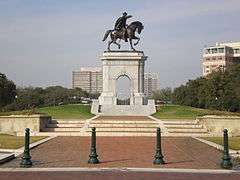 Sam Houston Monument at the northern end of Hermann Park | |
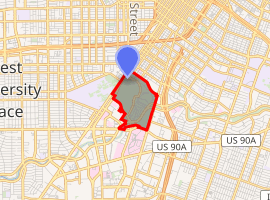
| |
| Type | Urban park |
| Location | Museum District, Houston, Texas, United States |
| Coordinates | 29°43′16″N 95°23′29″W |
| Area | 445 acres (180 ha) |
| Created | 1914 |
| Designer | George Kessler |
| Operated by | Hermann Park Conservancy City of Houston |
| Visitors | 6 million[1] |
| Open | 6 am – 11 pm daily |
| Public transit access | METRORail Red Line: Hermann Park / Rice University |
| Website | www |
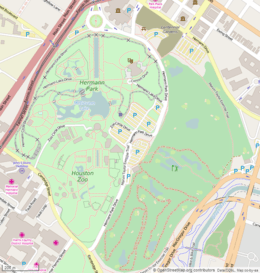
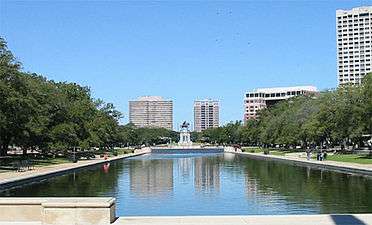
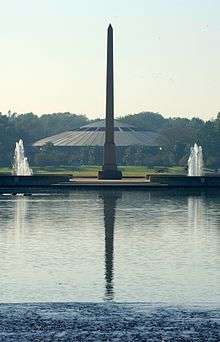
One of Houston's oldest public parks, Hermann Park was first envisioned as part of a comprehensive urban planning effort by the city of Houston in the early 1910s.[3] Following the recommendation of a 1913 report which identified the then-rural area between Main Street and Brays Bayou as ideal for a large urban park, real estate investor and entrepreneur George H. Hermann, who owned most of the area and served on the city's parks board, bequeathed his estate to Houston for use as a public green space in 1914.[3] By 1916, famed landscape architect George Kessler had completed a master plan for the park which was gradually implemented throughout the following decades.[3] Ultimately, Hermann Park and Rice University are two clear expressions of the City Beautiful movement in Houston.[4]
The opening of the Houston Zoo in 1922[5] and the requisition of a large southern portion of the park for the establishment of the Texas Medical Center in 1943[5] fundamentally altered the scope and configuration of the space, though significant elements of the Kessler plan—such as the north-south axis extending from Montrose Boulevard—remain and have been expanded upon.[3] Hermann Park experienced a period of neglect in the latter half of the 20th century due to a lack of funding and maintenance, spurring the formation of the nonprofit Hermann Park Conservancy in 1992. The Conservancy has since leveraged over $120 million of public and private funds to renovate and remake broad areas of the park.[1] Today, Hermann Park welcomes over six million visitors annually;[1] the Houston Zoo was the second most visited paid-admission zoo in the United States in 2016 (behind San Diego Zoo), with over 2.5 million visitors.[6]
Hermann Park is served by the Hermann Park / Rice University station on the METRORail Red Line, which runs along Fannin Street at the western edge of the park.
The Third Ward Redevelopment Council defines Hermann Park as being part of the Third Ward. T. R. Witcher of the Houston Press wrote in 1995 that the park and nearby areas are "not the first places that come to mind when you say "Third Ward,"[...]".[7]
History
- 1899 – Mayor Sam Brashear selected and purchased a site that would later on become the city’s first park in June 1899. The size of the land was 20.43 acres (8.27 ha) for $26,000. Prior to the purchase of the park, he formed the first park committee who oversaw the purchase and would later become Sam Houston Park.
- 1907 – The Houston Civic Club placed the Brownie statue donated to the City of Houston in Sam Houston Park. Brownie was created by artist Louis Amateis in 1905, and was first used as a children's water fountain. Over the years it has been stolen and recovered several times before finally residing in front of Miller Outdoor Theatre.
- 1914 – George E. Kessler designed the entrance of Hermann Park.
- 1924 – Hermann Park grew to 133.5 acres (54.0 ha) with the addition of the Golf Course in 1922, which completed construction in 1924. Its main feature that it had grass greens as opposed to the more commonly used sand in other cities and was well received by golfers.
- 1936 – for the City’s 100th anniversary, the Daughters of Republic of Texas had a log cabin constructed in Hermann Park as a memorial to pioneer men and women.
- 1957 – Southern Pacific steam engine #982 was dedicated at Hermann Park and the Mini-train service was established. The engine was saved after a newspaper letter from Peter Whitney got 75 replies and Southern Pacific donated the engine to the Junior Chamber of Commerce and the city. It took 5 days to move it from Blodgett to the Park, as rails were laid in the streets in front of it.[8] The locomotive was relocated by 50 wheel trailer to Minute Maid Park[9][10] in 2005.[11]
The Hermann Park Conservancy
Hermann Park was presented to the City of Houston by George Hermann in 1914, and is now Houston's most historically significant public green space. Over the years, the Houston Zoo, Miller Outdoor Theatre, the Houston Museum of Natural Science, and one of the first desegregated public golf courses in the United States all have added to the Park's importance as a recreational destination.
By the late 1980s however, due to insufficient public resources and very high public attendance, the park became rundown and entered a state of disrepair. In response, a group of committed and visionary Houstonians formed the nonprofit organization known as the Friends of Hermann Park (FHP) to encourage the development of more attractive, usable green space in Hermann Park and to promote the restoration of the Park to its originally intended standards of beauty.
Creating the Conservancy, Transforming the Park
In 1993, FHP commissioned a master plan for Hermann Park from Hanna/Olin Partnership of Philadelphia. This Master Plan, created in consultation with the City of Houston and various stakeholders, was adopted in 1997 by Houston City Council. In 1995, Friends of Hermann Park adopted a master plan for Hermann Park that has provided a “blueprint” for all subsequent renovations and enhancements to the Park. In 2004, Friends of Hermann Park changed its name to the Hermann Park Conservancy (HPC) to reflect an institutional and permanent commitment to stewardship of Hermann Park’s natural resources and physical infrastructure.
In an international competition, the Rice Design Alliance invited designers to set the tone and revitalize the main entry and reflecting pool that formed a key axis for Hermann Park, “The Heart of the Park”, and to create a contemporary update to the park's earliest plans by George Kessler and a subsequent, more formal Hare & Hare plan in 1936. SWA Group, an international landscape and urban design firm working in conjunction with W.O. Neuhaus Architects and other consultants, was selected over 100 respondents. The most striking of the changes to the 18-acre (7.3 ha) project area was a narrower, more inviting 80-foot-wide (24 m) by 740-foot-long (230 m) reflection pool. It establishes the formal central axis for the space and its slight narrower design afforded elegant pedestrian promenades as well as a double-row of mature Live Oak trees – one row that had been planted in the 1920s to honor veterans of WW I, and a second row that was added as part of the project. Noted in a winning entry for the 2005 National Award of Excellence from the American Society of Landscape Architects, the “Heart of the Park” reflecting pool utilized a biofiltration system of gravel beds and perforated pipes to trap organics so that they naturally decompose. Porous paving systems and decomposed granite also limit potential damage from increased water run-off from the site.
Ongoing projects
The Hermann Park Conservancy continues working in partnership with the City of Houston to secure funds and manage the design of projects to be undertaken in the Park:
- Mary Gibbs and Jesse H. Jones Reflection Pool
- Molly Ann Smith and Sara H. and John H. Lindsey Plazas
- Enlargement, renovation and beautification of McGovern Lake (including three new islands as well as bird and wetland habitat area.)
- The West Entrance facility and plaza for the Houston Zoo.
- Beautification and re-alignment of North MacGregor Street to improve access and circulation in and around the Park and the Texas Medical Center.
- Acquisition of additional land and capital improvements to Bayou Parkland, an 80-acre (32 ha) area in Hermann Park along Brays Bayou being "reclaimed" for healthier activities and used extensively for stewardship programs.
- Creation and implementation of extensive stewardship programs, including Field Studies 101, Natural Guard, and Scouting Around Hermann Park.
- Completion of the expansion and renovation of Miller Outdoor Theatre.
- Coordination of the comprehensive renovation of the Hermann Park Golf Course (completed by BSL Golf Corporation).
- Coordination of the Hermann Park Miniature Train track expansion.
- Planting of over 2,400 new trees.
- The park-wide installation of new park furnishings such as light fixtures, benches and trash cans.
The Conservancy also developed a Maintenance and Operations Master Plan Study for Hermann Park - the first such comprehensive study ever for this flagship park of Houston. The study identified many concerns for preserving and protecting Hermann Park, including a gap of 20,000 maintenance hours for the Park. In response, the Conservancy hired a Manager of Volunteer Programs. In 2004 over 1,200 volunteers provided over 14,000 hours of volunteer service in the park.
Attractions
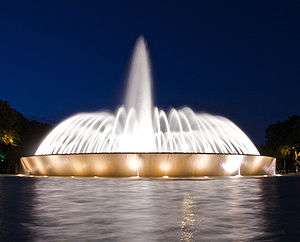
- Arbor in the Pines
- Bayou Parkland
- Bloch Plaza Cancer Survivor's Plaza
- Brays Bayou
- Buddy Carruth Playground for All Children
- Chinese Pagoda
- Hermann Park Golf Course[12]
- Hermann Park Jogging Trail
- Hermann Park Pedal Boats[13]
- Hermann Park Railroad (2 ft (610 mm) narrow gauge train ride)[13]
- Houston Garden Center[14]
- Fragrance Garden
- Houston Museum of Natural Science
- Cockrell Butterfly Center
- Houston Zoo
- Japanese Garden
- Judson Robinson, Jr. Community Center
- Lake Overlook
- Mary Gibbs and Jesse H. Jones Reflection Pool
- Marvin Taylor Exercise Station
- McGovern Centennial Gardens
- McGovern Lake
- Bob's Fishing Pier
- Mecom Fountain
- Miller Outdoor Theatre
- Molly Ann Smith Plaza, features four interactive fountains
- Pioneer Memorial
- Pioneer Memorial Log House Museum
- Sam Houston Monument
- Urban Forest in Bayou Parkland
References
- "Press Kit". Hermann Park Conservancy. 2017. Retrieved March 27, 2018.
- "McGovern Lake". Hermann Park Conservancy. 2018. Retrieved March 27, 2018.
- Fox, Stephen (Spring 1983). "Big Park, Little Plans: A History of Hermann Park" (PDF). Cite Magazine. 3: 18–21 – via Cite Magazine.
- Swartz, Mimi (September 17, 2015). "Green Acres". Texas Monthly. Retrieved March 27, 2018.
- Bradley, Barrie Scardino (2014). Houston's Hermann Park: A Century of Community. College Station: Texas A&M University Press. ISBN 9781623490362.
- Draper, Ryan (January 17, 2017). "Record Zoo Attendance for Ninth Consecutive Year". Houstonia. Retrieved November 18, 2018.
- Witcher, T.R. (1995-07-20). "Third Ward Rising". Houston Press. Retrieved 2020-03-18.
To the southwest, across Highway 288, lie [...] the towers of the Texas Medical Center, Houston's largest employment center -- not the first places that come to mind when you say "Third Ward," but which the redevelopment council includes as part of the community.
- Railway Magazine November 1958 p. 804
- History of Department p1 Archived June 24, 2007, at the Wayback Machine
- "Hermann Park train moves to new home" (). KHOU-TV. Friday August 26, 2005. Retrieved on December 23, 2015.
- JCI Houston - Southern Pacific 982
- Golf Houston, Texas - Hermann Park Golf Course - Downtown Houston Golf Course & Banquet Facility. Hermannparkgc.com. Retrieved on 2013-09-06.
- Hermann Park Conservancy. Hermannpark.org. Retrieved on 2018-02-20.
- Houston Garden Center. Houstontx.gov (2013-08-01). Retrieved on 2013-09-06.
Further reading
- "Hermann Park." In Houston: Present and Past in Contrast, Houston Chronicle.
- Hermann Park: A Brief History by Barrie Scardino (Archive) - Friends of Hermann Park Action Plan 2000
- Big Park, Little Plans: A History of Hermann Park by Stephen Fox (Archive)
External links
| Wikimedia Commons has media related to Hermann Park, Houston. |
